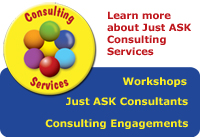
March 2016
Volume XIII Issue III
Share this newsletter on
Making a Visible Impact

Bruce Oliver, the author of Just for the ASKing!, lives in Burke, Virginia. He uses the knowledge, skills, and experience he acquired as a teacher, professional developer, mentor, and middle school principal as he works with school districts across the nation. He has written more than 150 issues of Just for the ASKing! He is also a co-author of Creating a Culture for Learning published by Just ASK.
John Hattie’s work was “visible” in session after session at the Learning Forward Annual Conference in December 2015. Participants had the opportunity to discuss his work, understand his findings at deeper levels, and make connections to their roles as professional educators.
Hattie’s book, Visible Learning: A Synthesis of Over 800 Meta-Analyses Relating to Achievement, was published in 2008. Hattie believes that many practices work in education but some practices yield greater results than others and have an overall greater impact on student learning. His findings are based on 15 years of research involving over 80 million students; additionally, he did a meta-analysis of more than 50,000 educational studies. His undertaking has been called “one of the largest collection of evidence-based research about what works best in education.” Further, his meta-study has been described by some as “teaching’s holy grail.” His work deserves our attention, analysis, and application.
Because Hattie’s work has important implications for our work as educators, this issue of Just for the ASKing! is devoted to capturing the essence of his work. It presents a synopsis of Hattie’s writings along with a resource section that provides multiple links to additional information.
Defining Visible Learning
Put succinctly, visible learning represents the practices and approaches that educators use to help students reach high standards. When teachers partake in a closer look at Hattie’s work, they become evaluators of their own teaching. They also begin to see learning from the viewpoint of their students instead of simply from their own perspective. As a result, teachers reflect on their own practice and ultimately become more empowered as they increase their ways to engage students in learning.
Applying Mind Frames
What Hattie has learned through his research is that there are certain “mind frames” that educators can employ as they look inward to evaluate their effectiveness. Hattie’s mind frames, which are stated simply and to the point, can be applied to the role of teacher or leader. As he has said, “It is critical that teachers see themselves as evaluators of their effects on students.” As well, leaders should examine their practices to determine what is working and not working as they support teachers. In Hattie’s original work, he delineated seven mind frames. Over time, he identified three additional frames. Peter DeWitt, a Visible Learning Trainer for Hattie’s work, provides the following descriptions of Hattie’s mind frames for both teachers and leaders:
- Teachers/leaders believe that their fundamental task is to evaluate the effect of their teaching on students’ learning and achievement. Hattie wrote, “The key factor is for teachers to have a mind frame in which they seek feedback about their influences on students and thus use this information to change, enhance, or continue their teaching methods.
- Teachers/leaders believe that success and failure in student learning is about what they, as teachers or leaders did or did not do. Teachers must see themselves as change agents. Thus, they must have high expectations for every learner and fully believe that learning is not fixed but that students can grow through appropriate instruction. Hattie believes that teachers must have the following positive beliefs about themselves:
- All students can be challenged.
- It’s all about strategies, never styles.
- It is important to develop high expectations for all students relative to their starting point.
- It is important to teach multiple learning strategies to all students.
- It is important to develop assessment-capable students.
- Critique, error, and feedback are powerful opportunities for improving learning.
- Don’t blame the kids.
- Handicaps of social class and home resources are surmountable.
- Teachers/leaders need to talk more about the learning than the teaching. In order to move the conversation to learning, Hattie asserts that schools should promote “collegial debates” that are not simply limited to best practices but also include discussions about how students learn, and share evidence of how students learn in different ways with one another.
- Teachers/leaders see assessment as feedback about their impact. Not only is feedback important for students but teachers also need feedback on their effectiveness of reaching each student. Hattie suggests that teachers ask themselves the following questions:
- Who did you teach well, who not so well?
- What did you teach well, what not so well?
- Where are the gaps, where are the strengths, what was achieved, and what has still to be achieved?
- How do we develop a common conception with the students and with the teachers in our school?
- Teachers/leaders engage in dialogue not monologue. Hattie is a firm believer that teachers must listen to what their students say. This includes … “listening to their questions, their ideas, their struggles, their strategies of learning, their successes, their interaction with peers, their outputs, and their views about the teaching.” Listening to student voices is especially pertinent for struggling or disengaged learners.
- Teachers/leaders enjoy the challenge and never retreat to saying I am “doing my best.” Hattie in an Ed Week blog maintains that every day is a challenge in the classroom. He writes, “The art of teaching is that what is challenging to one students may not be to another – hence the constant attention to the individual differences and seeking the commonality so that peers can work together with the teacher to make the difference.”
- Teachers/leaders believe it is their role to develop positive relationships in classrooms/staffrooms to then allow errors to thrive. Not only must the classroom be a place where students understand that is acceptable to make mistakes and to admit what they do not know, but school leaders must create a safe climate where teachers can talk openly about their teaching and its impact on student learning without undue judgment or criticism.
- Teachers/leaders adopt a common language that focuses more on learning than teaching. A common language enables practitioners around the world to be able to communicate about their discoveries and successes. DeWitt sees this as a crucial step that can help teachers focus on learner responses and temperaments, and thus change practitioner mindsets.
- Teachers/leaders understand that focusing on learning is hard work. Hattie makes no secret that adopting his set of beliefs and putting them into practice is no easy feat. He encourages educators to stay the course and dive deeply into analyzing the evidence they see before them, i.e., what and how their students learn.
- Teachers/leaders must collaborate. As Hattie has shared his work with practitioners, he has kept an open mind by adding additional mind frames as he has continued to learn himself. DeWitt writes, “Hattie not only has 10 mind frames but within his research he found 150 influences on learning, which continues to grow.” Hattie views collaboration as “collective teacher efficacy.” In our classrooms, we encourage collaboration among our students as an essential 21st century skill; if we are to be the best instructors we can be, we must practice what we preach.
Using the Highest Impact Practices
As teachers and leaders bring life to Hattie’s mind frames by making them a part of their regular applications, they must also take into account the findings Hattie published about high impact practices that have the greatest potential to increase student engagement and academic achievement. In multiple presentations focused on “Visible Learning, Tomorrow’s Schools, The Mindsets that Make the Difference,” Hattie ranks 138 influences on learning from those practices that had the most positive “effect size” to those which had negative impacts. In his writings on visible learning, Hattie not only provides an itemization of the applications but accompanies them with observations and stories underlying his conclusions. Below are the ten practices that Hattie has concluded make the greatest positive difference in student learning listed in order based on the highest impact:
- Student expectation of success includes such practices as teachers publicizing “I Can” messages, promoting student growth mindset, establishing academic and behavioral expectations, having students participate in course goal-setting, providing opportunities for students to monitor progress by self assessing and predicting grades, and teachers pressing for a deeper understanding of the content.
- Early intervention when students don’t learn means holding problem solving and planning conferences, anticipating learning gaps, and implementing RTI Tier 2 strategies.
- Advanced organizers incorporate conventions such as posting essential understandings, anticipating learning gaps, providing “heads up” cues as well as visual and graphic overviews of learning outcomes and learning sequences.
- Student-to-teacher and teacher-to-student feedback doubles one’s success rate. Teacher feedback encompasses academic and behavior check-ins, providing academic growth-producing feedback, and using formative assessment data to determine look for’s and provide corrective feedback. The new insight is for the teacher to listen carefully to student responses that can help them determine any instructional shifts that will improve learning.
- Student-teacher relationships encompass a range of behaviors including meet and greet at the classroom door, personal check-ins, and using student names to providing opportunities for student voice and holding 1:1 conferences.
- Verbalization and questioning through reflection and discussion provide opportunities for students to work in pairs or small groups. In order to increase students engagement and comprehension, teachers develop a repertoire of text protocols that broaden perspectives, encourage open discussions and information sharing, and narrow a piece of writing to its essential elements.
- Problem-solving teaching is an on-going process that provides students with a wide variety of skill-building opportunities including seeking information, generating new knowledge, identifying various solutions, and making decisions.
- Intentional teaching of study skills is essential since knowing how to study rarely comes naturally. Providing specific strategies and modeling those ideas gives students a menu of options such as creating routines, and establishing organizational skills that can have a major impact on student performance.
- Cooperative learning experiences for students can result in greater learning gains and also develop interpersonal relationship skills, as well as a greater sense of well-being and belonging. As Hattie has said, “If you want to increase student academic achievement, give each student a friend.”
- Classroom cohesion provides an environment where students feel comfortable, welcomed, and appreciated. Teacher behaviors that contribute to cohesion include adherence to established procedures, clear directions, effective pacing, proximity to students, positive directives, and class circle activities.
John Hattie’s work supplies all of us with excellent “food for thought” as well as convincing arguments for “food for action.”
Permission is granted for reprinting and distribution of this newsletter for non-commercial use only. Please include the following citation on all copies:
Oliver, Bruce. “Making a Visible Impact.” Just for the ASKing! March 2016. Reproduced with permission of Just ASK Publications & Professional Development (Just ASK). © 2016 Just ASK. All rights reserved. Available at www.justaskpublications.com.



